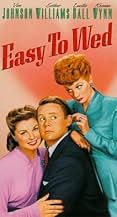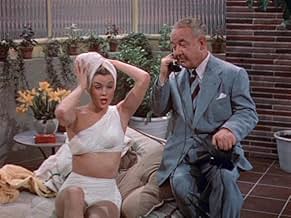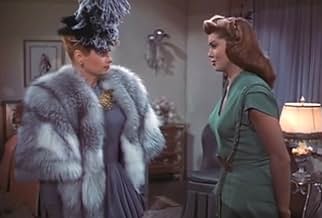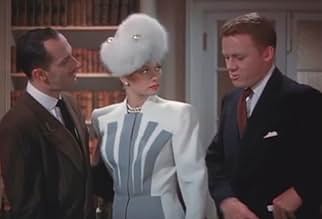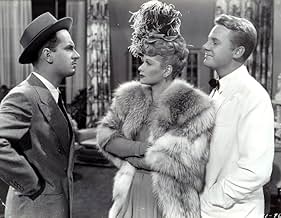CALIFICACIÓN DE IMDb
6.1/10
989
TU CALIFICACIÓN
Para evitar un caso por difamación contra el periódico, un periodista trata de comprometer la reputación de la calumniada hija de un magnate.Para evitar un caso por difamación contra el periódico, un periodista trata de comprometer la reputación de la calumniada hija de un magnate.Para evitar un caso por difamación contra el periódico, un periodista trata de comprometer la reputación de la calumniada hija de un magnate.
- Dirección
- Guionistas
- Elenco
Carlos Ramírez
- Carlos Ramírez
- (as Carlos Ramirez)
William Bailey
- Newspaper Office Worker
- (sin créditos)
Opiniones destacadas
"Libeled Lady" is one of the best comedies of the 1930s. Much of was the writing and much was due to the incredibly strong cast. Think about it---Spencer Tracy, Myrna Loy, Jean Harlow and William Powell--ALL in one film! In 1946, MGM brought out a remake. While the basic story is similar, it's not as good. Plus, Esther Williams, Van Johnson, Keenan Wynn and Lucille Ball just weren't as good--though they tried.
Like "Libeled Lady", the film is about a rich lady who is suing an irresponsible newspaper for its stories about her. However, oddly, in the original she was suing for $5,000,000 and here, a decade later, it's only $2,000,000--significant deflation, don't you think? To help try to get rid of the suit, the scheming newspaper man, Haggerty (Wynn), hires Bill Chandler (Van Johnson) to seduce the heiress, Connie Allenbury (Williams). Why? Because, in the interim, they'd get Bill a quickie marriage. Then, they'd have the 'jealous wife' storm in on them and threaten a suit of her own--along with photographers from the paper to make her case! But, since Bill isn't married, Haggerty has Chandler marry HIS fiancée (Lucille Ball)! Talk about romantic--getting Chandler to marry Haggerty's girl! There's only one problem with the plan...Bill falls for Connie and just can't get himself to do it. So, he schemes for a way to somehow please Haggerty AND Connie...if it's possible.
The film is decent and offers a few laughs. However it suffers from a few plot problems (Connie's falling in love with Bill seems incredibly fast considering how nasty she'd been towards him up until then), now includes song which got in the way of the plot and the characters aren't particularly likable (Connie is amazingly nasty--and for no reason--when she first meets Bill). Plus, it lacks the originality and fun of the first film. If you like remakes, by all means see this one. But, don't forget to first see "Libeled Lady"--it's just better.
By the way, the plot of "Easy to Wed" is very, very odd considering only about six months later, Keenan Wynn and his real-life wife divorced....so she could marry Van Johnson! To make it even weirder, it now appears that this, like the marriage in the movie, was a sham marriage, as in his later years Johnson admitted to being gay--and I sincerely doubt that this was a sudden late-life 'phase'!
Like "Libeled Lady", the film is about a rich lady who is suing an irresponsible newspaper for its stories about her. However, oddly, in the original she was suing for $5,000,000 and here, a decade later, it's only $2,000,000--significant deflation, don't you think? To help try to get rid of the suit, the scheming newspaper man, Haggerty (Wynn), hires Bill Chandler (Van Johnson) to seduce the heiress, Connie Allenbury (Williams). Why? Because, in the interim, they'd get Bill a quickie marriage. Then, they'd have the 'jealous wife' storm in on them and threaten a suit of her own--along with photographers from the paper to make her case! But, since Bill isn't married, Haggerty has Chandler marry HIS fiancée (Lucille Ball)! Talk about romantic--getting Chandler to marry Haggerty's girl! There's only one problem with the plan...Bill falls for Connie and just can't get himself to do it. So, he schemes for a way to somehow please Haggerty AND Connie...if it's possible.
The film is decent and offers a few laughs. However it suffers from a few plot problems (Connie's falling in love with Bill seems incredibly fast considering how nasty she'd been towards him up until then), now includes song which got in the way of the plot and the characters aren't particularly likable (Connie is amazingly nasty--and for no reason--when she first meets Bill). Plus, it lacks the originality and fun of the first film. If you like remakes, by all means see this one. But, don't forget to first see "Libeled Lady"--it's just better.
By the way, the plot of "Easy to Wed" is very, very odd considering only about six months later, Keenan Wynn and his real-life wife divorced....so she could marry Van Johnson! To make it even weirder, it now appears that this, like the marriage in the movie, was a sham marriage, as in his later years Johnson admitted to being gay--and I sincerely doubt that this was a sudden late-life 'phase'!
This is one of the few times at MGM Lucy was given a chance to exploit her full comedic range, and she goes at it with gusto. From the moment she makes her whirlwind entrance looking absolutely gorgeous in a white wedding gown, she commands the screen whenever the camera is on her. In fact, though the movie ostensibly "stars" Van Johnson and Esther Williams, the bland leads take a back seat to the lively pairing of Lucy and Keenan Wynn, as her somewhat morally corrupt boyfriend. Forget comparisons to "Libeled Lady"; "Easy to Wed" is of a different era, and much more slapsticky, and, as noted, Lucy is a gem whether getting drunk and playing the piano or evincing true pathos as a wronged woman. She has rarely been photographed more appealingly, either.
As the other comments here indicate, it's highly instructive to compare LIBELED LADY to this remake, EASY TO WED. A decade brought a huge difference in style between the Thalberg-approved slangy courtship of slapstick repartee and the plush, earnest romance of Louis B. Mayer's MGM of the '40s.
Lucille Ball steals this picture with a very well-judged comic performance, aided by director Edward Buzzell, who clearly throws many scenes her way. What will surprise those who know her primarily from "I Love Lucy" is to see how much of her comic shtick is already on view here, completely developed and intact. The drunk scene, the little voices, the 'takes,' stares, reactions and expressions are familiar in every way as Lucy Ricardo. Ball also never looked more beautiful than in this film, with her hair as metallic and bright as a new penny, and in a series of witty and gorgeous costumes by Irene, who does just as well by Esther Williams.
But those who are critical of Ball's performance, particularly in contrast to Jean Harlow's in LIBELED LADY, are right. Harlow was a natural, a wonderful, winning and unique personality, whose blustering scenes of anger were always justified, always expressing her common sense and dignity. The dirty little secret about why Lucille Ball never made it as a movie star was that despite her professionalism and beauty, she was essentially a strident and cold personality. What Harlow did naturally, Ball works very hard to achieve so that we admire her pyrotechnics without ever warming up to her. By the time of "I Love Lucy" she had begun to disguise her intensity with clutziness and feigned vulnerability and stupidity. And like Katharine Hepburn, she learned that if Lucy was reined-in by a man once in a while, audiences could forgive her for her aggressiveness.
There is relatively little of Esther Williams' swimming in this picture. At this mid-'40s point, MGM was pushing her versatility to see just how much she could do, how far she could go. I happen to think that her screen presence (even when out of the water) is underrated. She had a refreshing, no-nonsense self confidence that is very American, and she was sexy in a way that is never blatant. The fact that this statuesque beauty with her strong physical presence and perfect carriage never acts seductively or coyly creates an unexpected sexual tension, especially in her early films (she lost a bit of it later as her body became thicker and more athletic). You can see how some would feel moved to ruffle her composure, warm her up, 'get' to her in some way, because she seems oblivious to her femininity while brimming over with it. Which is what makes her seem an emblematic American movie star. In the first half of this picture she gives a good account of the kind of frigid glamor girl that Alexis Smith often played at Warners.' When she finally melts, it's lovely, though she is better photographed in both THRILL OF A ROMANCE and THIS TIME FOR KEEPS (where she rates closeups by Karl Freund that make her look almost impossibly, lustrously beautiful).
A word about MGM's '40s Technicolor -- I love it. Many films from this period as screened on TCM seem to have been saved, restored, remastered for video tapes and DVDs. All of Esther Williams' color films from the mid-'40s are a visual treat with bright, deeply saturated color and sharp images, though a few scenes in EASY TO WED seem unaccountably muddy and soft, with desaturated color. And in one scene Ball wears a frosty blue costume that we have been told is green. Maybe they should take a look at this print before they put this film out on DVD.
Lucille Ball steals this picture with a very well-judged comic performance, aided by director Edward Buzzell, who clearly throws many scenes her way. What will surprise those who know her primarily from "I Love Lucy" is to see how much of her comic shtick is already on view here, completely developed and intact. The drunk scene, the little voices, the 'takes,' stares, reactions and expressions are familiar in every way as Lucy Ricardo. Ball also never looked more beautiful than in this film, with her hair as metallic and bright as a new penny, and in a series of witty and gorgeous costumes by Irene, who does just as well by Esther Williams.
But those who are critical of Ball's performance, particularly in contrast to Jean Harlow's in LIBELED LADY, are right. Harlow was a natural, a wonderful, winning and unique personality, whose blustering scenes of anger were always justified, always expressing her common sense and dignity. The dirty little secret about why Lucille Ball never made it as a movie star was that despite her professionalism and beauty, she was essentially a strident and cold personality. What Harlow did naturally, Ball works very hard to achieve so that we admire her pyrotechnics without ever warming up to her. By the time of "I Love Lucy" she had begun to disguise her intensity with clutziness and feigned vulnerability and stupidity. And like Katharine Hepburn, she learned that if Lucy was reined-in by a man once in a while, audiences could forgive her for her aggressiveness.
There is relatively little of Esther Williams' swimming in this picture. At this mid-'40s point, MGM was pushing her versatility to see just how much she could do, how far she could go. I happen to think that her screen presence (even when out of the water) is underrated. She had a refreshing, no-nonsense self confidence that is very American, and she was sexy in a way that is never blatant. The fact that this statuesque beauty with her strong physical presence and perfect carriage never acts seductively or coyly creates an unexpected sexual tension, especially in her early films (she lost a bit of it later as her body became thicker and more athletic). You can see how some would feel moved to ruffle her composure, warm her up, 'get' to her in some way, because she seems oblivious to her femininity while brimming over with it. Which is what makes her seem an emblematic American movie star. In the first half of this picture she gives a good account of the kind of frigid glamor girl that Alexis Smith often played at Warners.' When she finally melts, it's lovely, though she is better photographed in both THRILL OF A ROMANCE and THIS TIME FOR KEEPS (where she rates closeups by Karl Freund that make her look almost impossibly, lustrously beautiful).
A word about MGM's '40s Technicolor -- I love it. Many films from this period as screened on TCM seem to have been saved, restored, remastered for video tapes and DVDs. All of Esther Williams' color films from the mid-'40s are a visual treat with bright, deeply saturated color and sharp images, though a few scenes in EASY TO WED seem unaccountably muddy and soft, with desaturated color. And in one scene Ball wears a frosty blue costume that we have been told is green. Maybe they should take a look at this print before they put this film out on DVD.
Lucy obviously had her talents (though I'm not much of a fan of her television stuff) and she has a few good scenes here. But watching her do the big blow up speech at the end word for word the same as Jean Harlow, we see she had nowhere near the talent as Harlow. Harlow did that scene with such humanity and timing. This had none of that.
I almost never see the reason for remakes, very few are anywhere near as good as the original and this is a great example. Watch the original, much better.
I almost never see the reason for remakes, very few are anywhere near as good as the original and this is a great example. Watch the original, much better.
This film has its plusses -- Esthers swimming, her swimming, and her swimming. It's also in technicolor, which is always a treat to the eye. It really surprised me that a socco screenplay that made 1936's Libled Lady such a rip-roaring funny film could go so flat 10 years later. Of course Myrna Loy, Jean Harlow, William Powell, and Spencer Tracy were more highly skilled performers than this cast. Williams has some to the stoic, amused calm that Loy had and she does okay as Connie, but Lucille Ball is almost unfunny in this, which really surprised me. She lacks Harlows warmth and vulnerability and timing. Harlow really carried Libled Lady and one always looks forward to her scenes. Ball is too arch and steely here. It puts a damper on the films success.
¿Sabías que…?
- TriviaA remake of one of the great comedies of the 1930s - Los enredos de una dama (1936) with Jean Harlow, William Powell, Myrna Loy, and Spencer Tracy.
- Citas
William Stevens 'Bill' Chandler: You're too modest. Why, you're a woman of great depths, depths that have never been plumbed.
Gladys Benton: [referring to her boyfriend] No, Warren's not much of a plumber.
- ConexionesFeatured in Lucy and Desi: A Home Movie (1993)
- Bandas sonorasContinental Polka
Lyrics by Ralph Blane
Music by Johnny Green
Sung and Danced by Lucille Ball (dubbed by Virginia Rees) and chorus
Selecciones populares
Inicia sesión para calificar y agrega a la lista de videos para obtener recomendaciones personalizadas
- How long is Easy to Wed?Con tecnología de Alexa
Detalles
Taquilla
- Presupuesto
- USD 1,683,000 (estimado)
- Tiempo de ejecución1 hora 50 minutos
- Relación de aspecto
- 1.37 : 1
Contribuir a esta página
Sugiere una edición o agrega el contenido que falta

Principales brechas de datos
What is the Spanish language plot outline for Que siga la boda (1946)?
Responda

